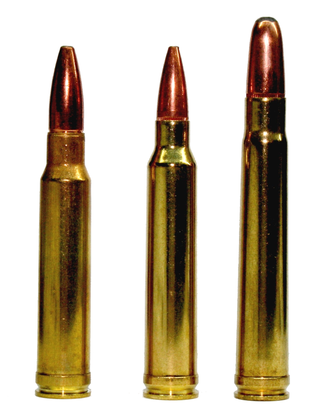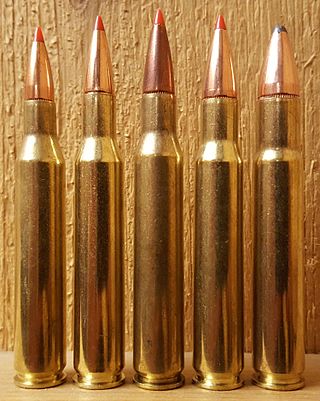
Weatherby, Inc. is an American gun manufacturer founded in 1945 by Roy Weatherby. The company is best known for its high-powered magnum cartridges, such as the .257 Weatherby Magnum, .270 Weatherby Magnum, .300 Weatherby Magnum, .340 Weatherby Magnum and the .460 Weatherby Magnum. The company's headquarters is in Sheridan, Wyoming.
The .416 Rigby is a rifle cartridge designed in 1911 by London based gunmaker John Rigby & Company, for hunting dangerous game. It is the first cartridge to use a bullet of .416 inch diameter. The rifles, as built by John Rigby & Co., were initially made up on the Magnum Mauser 98 action, although in later years, some were made on standard length actions, a perfect example being the rifle used by legendary professional hunter Harry Selby. Other famous users of the cartridge were Commander David Enderby Blunt, John Taylor, and Jack O'Connor.

The .375 H&H Magnum, also known as .375 Holland & Holland Magnum, is a medium-bore rifle cartridge introduced in 1912 by London based gunmaker Holland & Holland. The .375 H&H cartridge featured a belt to ensure the correct headspace, which otherwise might be unreliable, given the narrow shoulder of the cartridge case. The cartridge was designed to use cordite which was made in long strands – hence the tapered shape of the case, which, as a beneficial side effect also helped in smooth chambering and extraction from a rifle's breech.
The Whisper family of firearm cartridges is a group of wildcat cartridges developed in the early 1990s by J.D. Jones at SSK Industries. The Whisper family was developed as a line of accurate, multi-purpose cartridges using relatively heavy rifle bullets for a given caliber in subsonic loads. The intention was to create an extremely accurate cartridge family for military, police, competition and specialized hunting markets that could also be easily sound suppressed.

The 7mm Remington Magnum rifle cartridge was introduced as a commercially available round in 1962, along with the new Remington Model 700 bolt-action rifle. It is a member of the belted magnum family that is directly derived from the venerable .375 H&H Magnum. The original purpose of the belted magnum concept taken from the .300 H&H Magnum and .375 H&H Magnum, was to provide precise headspace control, since the sloping shoulders, while easing cartridge extraction, were unsuitable for this purpose. Improved cartridge extraction reliability is desirable while hunting dangerous game, in particular when a fast follow-up shot is required. The 7mm Remington Magnum is based on the commercial .264 Winchester Magnum, .338 Winchester Magnum, and .458 Winchester Magnum, which were based on the same belted .300 H&H Magnum and .375 H&H Magnum cases, trimmed to nearly the same length as the .270 Weatherby Magnum.

The term belted magnum or belted case refers to any cartridge, but generally a rifle cartridge, with a shell casing that has a pronounced "belt" around its base that continues 2–4 mm (0.079–0.157 in) past the extractor groove.
The .416 Weatherby Magnum is a belted, bottlenecked cartridge designed by Ed Weatherby and launched commercially in 1989. It is a dangerous-game cartridge intended for the hunting of heavy dangerous game such as elephant and African Cape buffalo. It is considered the most powerful commercial .416 cartridge, besting the Remington, Rigby and Ruger .416s by a velocity of 300 ft/s (91 m/s). Unlike earlier Weatherby cartridges which were designed by Roy Weatherby, this cartridge was designed by his son Ed Weatherby.
The .264 Winchester Magnum is a belted, bottlenecked rifle cartridge. Except for the .244 H&H Magnum and .257 Weatherby Magnum, it is the smallest caliber factory cartridge derived from the 2.85 in (72 mm) Holland & Holland belted magnum case. It was introduced in the late 1950s and early 1960s with the .338 Winchester Magnum and the .458 Winchester Magnum as one of a family of short-cased 2.5 in (64 mm) belted magnum cartridges developed by Winchester based on the .375 Holland & Holland parent case. It was officially introduced to the public by Winchester in 1959. After many years of dwindling use it began enjoying a mild resurgence in popularity in the mid-2000s among long range rifle enthusiasts and reloaders due to the high ballistic coefficient of the heavier 6.5mm bullets and increasing popularity of cartridges such as 6.5mm Creedmoor, .260 Remington, 6.5 Grendel, benchrest and wildcat cartridges in 6.5mm.

The .404 Jeffery is a rifle cartridge designed for hunting large, dangerous game animals, such as the "Big Five" of Africa. The cartridge is standardized by the C.I.P. and is also known as .404 Rimless Nitro Express. It was designed in 1905 by London based gunmaker W.J. Jeffery & Co to duplicate the performance of the .450/400 Nitro Express 3-inch in bolt-action rifles. The .404 Jeffery fired a bullet of .422 in (10.72 mm) diameter of either 300 gr (19 g) with a muzzle velocity of 2,600 ft/s (790 m/s) and muzzle energy of 4,500 foot-pounds force (6,100 N⋅m) or 400 gr (26 g) with a muzzle velocity of 2,150 ft/s (660 m/s) and 4,100 foot-pounds force (5,600 N⋅m) of energy. It is very effective on large game and is favored by many hunters of dangerous game. The .404 Jeffery was popular with hunters and game wardens in Africa because of its good performance with manageable recoil. By way of comparison, the .416 Rigby and .416 Remington Magnum cartridges fire .416 in (10.57 mm) bullets of 400 gr at 2,400 feet per second (730 m/s) with a muzzle energy of approximately 5,000 foot-pounds force (6,800 N⋅m). These cartridges exceed the ballistic performance of the .404 Jeffery but at the price of greater recoil and, in the case of the .416 Rigby, rifles that are more expensive.

The .416 Remington Magnum is a .416 caliber (10.57 mm) cartridge of belted bottlenecked design. The cartridge was intended as a dangerous game hunting cartridge and released to the public in 1989. The cartridge uses the case of the 8 mm Remington Magnum as a parent cartridge. When the cartridge was released in 1988, author Frank C. Barnes considered the .416 Remington Magnum to be the "most outstanding factory cartridge introduced in decades".
The .375 Ruger (9.5×65.5mm) is a rimless, standard-length rifle cartridge designed for hunting large, dangerous game. It is designed to provide an increase in performance over the .375 H&H cartridge within the context of a standard-length rifle action. The cartridge was designed in partnership by Hornady and Ruger. In 2007, it was released commercially and chambered in the Ruger Hawkeye African and the Ruger Hawkeye Alaskan rifles.

The .375 Weatherby Magnum (9.5×73mmB) is a medium-bore rifle cartridge. The cartridge is blown out, improved and provided with the Weatherby double radius shoulder – given the Weatherby treatment – version of the .375 H&H Magnum. Unlike other improved versions of the .375 H&H Magnum like the .375 Ackley Improved, the .375 Weatherby Magnum is not a wildcat and existed as a proprietary cartridge until the CIP published specifications for the cartridge.
The .400 H&H Magnum also known as .400 Holland & Holland Magnum is a belted rimless bottlenecked cartridge introduced by Holland & Holland. The cartridge was released together with the .465 H&H Magnum in 2003. It is based on the .375 H&H Magnum case.

.30-06 Springfield wildcat cartridges are cartridges developed from a 30-06 Springfield "parent cartridge" through narrowing or widening the cartridge neck to fit a smaller or larger bullet in an attempt to improve performance in specific areas. Such wildcat cartridges are not standardized with recognized small arms standardization bodies like the SAAMI and the CIP.
The .450 Rigby is a rifle cartridge designed in 1994 by John Rigby & Co. for the hunting of large, thick-skinned dangerous game animals in Africa. The cartridge is based on the .416 Rigby necked up to accept a .458 in (11.6 mm) bullet and is intended for use in magazine rifles. The cartridge should not be confused with .450 Nitro Express which was introduced by Rigby in 1898, and is a rimmed cartridge intended for use in double rifles.
The Ruger American Rifle is a family of budget-level hunting/sporting bolt-action centerfire rifle made by Sturm, Ruger & Co., which also produces a line of rimfire rifles with similar designs called the Ruger American Rimfire.
The .338 Ruger Compact Magnum or .338 RCM is a rimless, short-length rifle cartridge based on the .375 Ruger case. Sturm Ruger and Hornady jointly developed the round, which was released in 2008 and chambered in various Ruger rifles. The goal of the project was to produce a .338 caliber cartridge with magnum level performance that would fit in a compact, short action rifle. The .338 RCM is conceptually similar to the WSM cartridge family, but is somewhat smaller dimensionally. This often allows for a higher magazine capacity than the WSM equivalent. Like the .338 caliber cartridges which predated it, the round is designed for hunting medium to large sized North American game.









